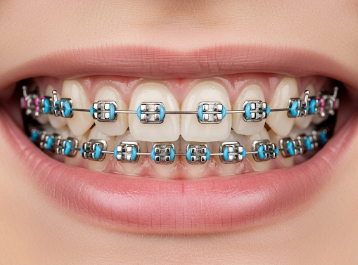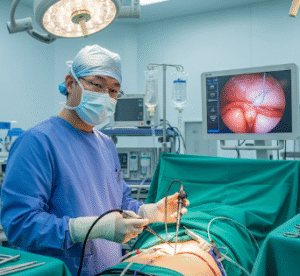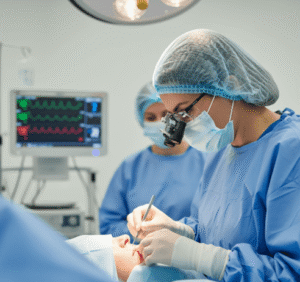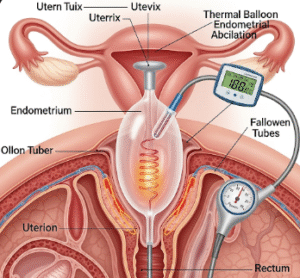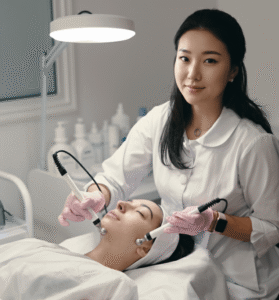Overview
Braces and orthodontics are dental treatments designed to correct misaligned teeth, improper bites, and jaw irregularities. Orthodontic care not only improves appearance and self-confidence but also contributes to oral health, proper chewing, and speech.
Importance of orthodontics:
- Corrects crowded, crooked, or spaced teeth.
- Aligns bite for proper chewing and jaw function.
- Prevents tooth wear, gum disease, and jaw pain.
- Enhances aesthetics and facial symmetry.
In South Korea, orthodontics is widely available in dental clinics and specialized orthodontic centers, with advanced techniques including metal braces, ceramic braces, lingual braces, and clear aligners like Invisalign.
Why It’s Done
Orthodontic treatment is performed to improve oral function and aesthetics.
Common indications include:
- ➤ Malocclusion: Overbite, underbite, crossbite, open bite.
- ➤ Crowded or crooked teeth: Difficulty cleaning and maintaining oral hygiene.
- ➤ Gaps between teeth: Cosmetic or functional concerns.
- ➤ Jaw misalignment: Causing pain, speech difficulties, or temporomandibular joint (TMJ) disorders.
- ➤ Prevention of dental complications: Reduces risk of tooth decay, gum disease, and abnormal wear.
- ➤ Enhancing facial aesthetics: Aligns teeth for a more balanced smile and facial structure.
Benefits for patients:
- ✔️ Improved oral health and hygiene.
- ✔️ Corrected bite and jaw function.
- ✔️ Enhanced confidence and aesthetics.
- ✔️ Prevention of future dental complications.
Alternatives
While traditional braces are common, several alternatives exist:
- ➤ Clear aligners (Invisalign): Removable, nearly invisible trays for gradual teeth movement.
- ➤ Lingual braces: Placed on the back of teeth for discreet treatment.
- ➤ Ceramic braces: Tooth-colored brackets for less visible appearance.
- ➤ Orthodontic retainers: Minor teeth alignment corrections or post-braces maintenance.
- ➤ Surgical orthodontics: For severe jaw misalignments, combined with braces for comprehensive correction.
Key point: Selection depends on severity, aesthetic preference, age, and budget.
Preparation
Orthodontic treatment requires careful planning and dental assessment.
Steps include:
- ✅ Comprehensive dental evaluation: X-rays, photos, and dental impressions.
- ✅ Oral health check: Treat cavities, gum disease, or other dental issues prior to braces.
- ✅ Treatment planning: Choose type of braces, duration, and expected outcomes.
- ✅ Consent and education: Inform patient about maintenance, diet restrictions, and follow-ups.
Important: Proper oral hygiene and preparation ensure effective treatment and reduce complications.
How It’s Done
Orthodontic treatment involves gradual movement of teeth into desired positions.
Step-by-step process for braces:
- Initial consultation: Examine teeth, bite, and jaw alignment.
- Dental impressions and imaging: Models or 3D scans created.
- Braces placement:
- Brackets bonded to teeth.
- Archwires connected using elastic or metal ligatures.
- Periodic adjustments: Teeth gradually move with pressure applied through wires; adjustments every 4–8 weeks.
- Oral care education: Proper brushing, flossing, and avoiding certain foods.
- Retention phase: After braces removal, retainers are worn to maintain alignment.
Alternative methods (Invisalign or lingual braces):
- Removable trays (Invisalign) replaced every 1–2 weeks.
- Lingual braces function like traditional braces but are hidden behind teeth.
Duration: Typically 18–36 months, depending on complexity.
Pain level: Mild discomfort after adjustments, manageable with over-the-counter pain relief.
Recovery & Follow-up
Orthodontic treatment requires continuous monitoring and patient cooperation.
Immediate post-placement:
- Mild soreness or pressure for a few days.
- Avoid hard, sticky, or chewy foods.
During treatment:
- Regular follow-ups every 4–8 weeks.
- Address broken brackets or loose wires promptly.
After treatment (retention phase):
- Retainers worn as prescribed to prevent teeth from shifting.
- Periodic check-ups every 6–12 months recommended.
Important: Oral hygiene is critical throughout treatment to prevent cavities and gum disease.
Possible Complications
While generally safe, orthodontic treatment may have risks:
- ⚠️ Tooth decay or gum disease if oral hygiene is poor.
- ⚠️ Mild root resorption (shortening of tooth roots) in some cases.
- ⚠️ Soft tissue irritation – lips, cheeks, or tongue discomfort.
- ⚠️ Allergic reactions – rare, to metal or latex components.
- ⚠️ Relapse – teeth may shift if retainers are not worn consistently.
- ⚠️ Jaw discomfort – temporary pain during bite adjustments.
In South Korea, advanced technology, patient education, and regular follow-ups minimize risks and ensure safe outcomes.
Treatment Options / Clinical Relevance in Korea
Orthodontics in South Korea is a well-developed, highly specialized field.
Key features:
- 🏥 Comprehensive orthodontic clinics offering metal, ceramic, lingual braces, and clear aligners.
- 🏥 Advanced imaging and 3D planning for precise treatment.
- 🏥 Multidisciplinary approach – orthodontists collaborate with oral surgeons, pediatric dentists, and prosthodontists.
- 🏥 Pediatric and adult care – treatments available from early childhood to adulthood.
- 🏥 Cosmetic orthodontics – focus on aesthetics with clear or lingual braces.
Highlights in Korea:
- ✔️ Advanced orthodontic technologies for faster, safer treatment.
- ✔️ Customized treatment plans based on individual dental anatomy.
- ✔️ Integration of digital imaging and 3D printing for precise bracket placement.
- ✔️ Excellent post-treatment follow-up ensures long-term results.
Highlights
- ➤ Braces and orthodontics correct misaligned teeth, bite issues, and jaw irregularities.
- ➤ Treatment improves oral health, aesthetics, and self-confidence.
- ➤ Options include metal braces, ceramic braces, lingual braces, and clear aligners.
- ➤ Preparation involves dental evaluation, imaging, and oral health management.
- ➤ Treatment requires regular adjustments and follow-ups, typically 18–36 months.
- ➤ Complications are minimal if proper care and hygiene are maintained.
- ➤ South Korea offers advanced orthodontic care, using modern technology and multidisciplinary approaches.

